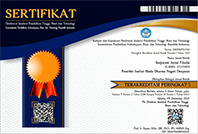TARI SANDAR SEBAGAI BENTENG PERTAHANAN ADAT DI DESA ADAT KEDONGANAN KUTA
DOI:
https://doi.org/10.25078/sanjiwani.v9i2.2097Kata Kunci:
Sandar Dance; Magis Fortress; Traditional VillageAbstrak
Performing art in Bali is a cultural repertoire that is very tied to the diversity of forms and goals. The island of Bali, dubbed the Island of the Gods, Khayangan Island (Island of Paradise) has a variety of dances that vary in shape and have a close relationship with the implementation of Hindu religious ceremonies which are the largest in number in Bali. The attraction of Bali is its unique culture, community life and natural beauty. Its cultural life is the unification of religion, culture, harmonious customs, taste and intention as a prominent element of human cultivation taking the form of religion, aesthetics and ethics. This is reflected through cultural arts, solidarity of mutual cooperation as a sense of togetherness.
As a tradition, the existence of Balinese art is in line with all aspects of life. In an integrated manner, reflecting on the ideals of the supporting community is not excessive if the Balinese people consider that art (dance, gamelan and wayang) is an integral part of their lives which is always bound by ritual events. Hinduism which has rational, ritual, emotional and belief elements often makes the art as a ritual drama a means to strengthen trust and formulate religious conceptions in people’s lives.
















